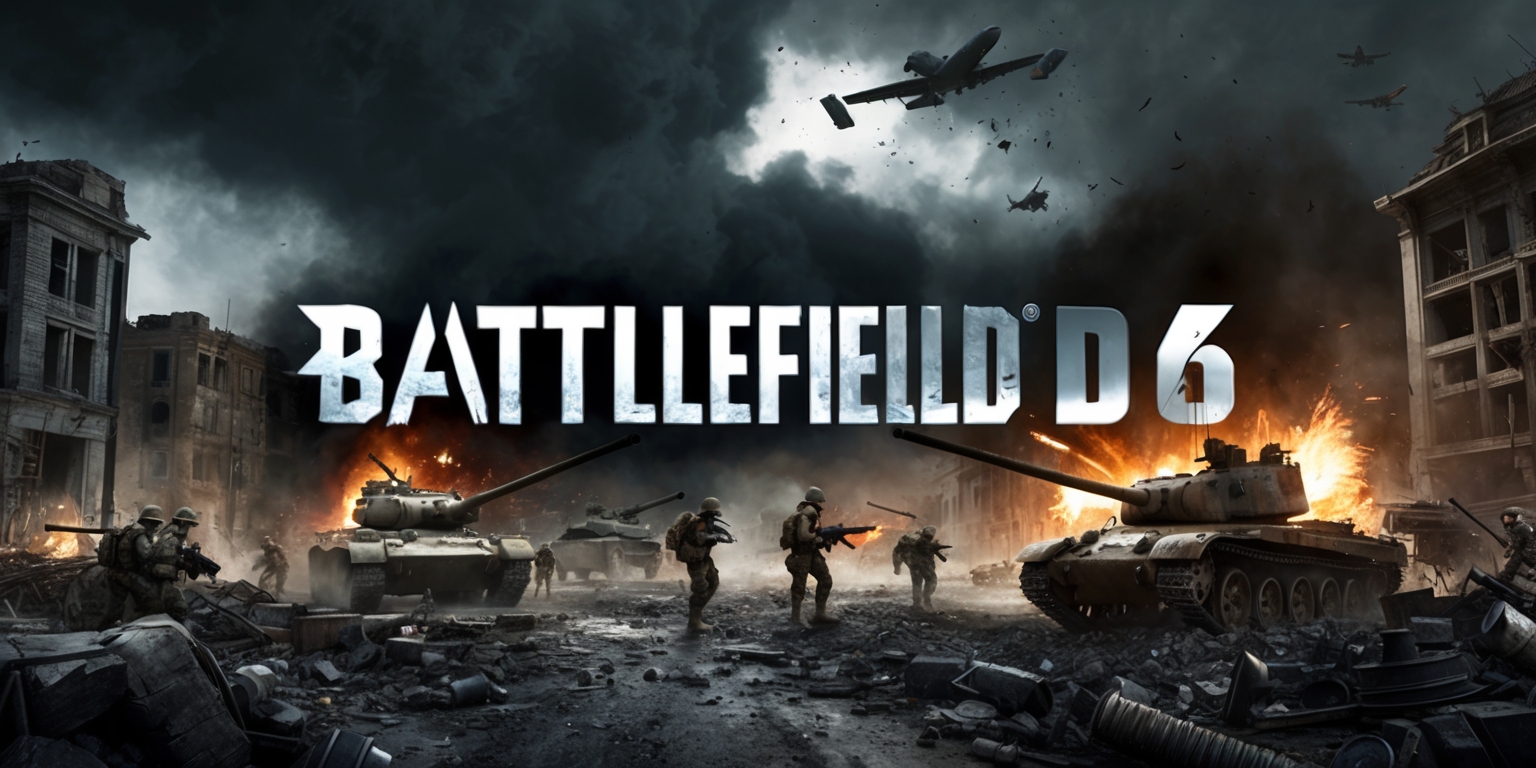Commanding the Digital Battlefield: Mastering Keyboard and Mouse Customization in Battlefield 6

In the dynamic realm of Battlefield 6, the finesse of your keyboard and mouse settings can This nuance ultimately determines whether the experience comes off as seamless or ends up being filled with complications frustrating delays on the virtual battlefield. Players, whether newcomers or veterans, have a unique opportunity to tailor every control—transforming split-second actions into purposeful maneuvers with precision. This tailored approach empowers users to adjust keybinds, sensitivity, and interaction commands to suit individual gameplay strategies. As Battlefield 6 evolves with its intricate combat systems, understanding these adjustments and their impacts becomes essential for gameplay mastery and overall satisfaction.
Accessing the Game’s Detailed Settings
Embarking on a quest to elevate your performance starts right within Battlefield 6’s settings, accessible by clicking the cog icon in the main menu. This action opens up a realm of customization options, neatly organized by categories that include mouse and keyboard configurations. Navigating through these menus reveals a wealth of adjustments designed to fine-tune everything from movement commands to weapon fire modes. The interface encourages experimentation, allowing both casual and seasoned players to refine controls until they achieve optimal responsiveness. Moreover, these settings reflect a balanced approach to modern gameplay design, bridging the gap between traditional controller usage and the precision of a keyboard and mouse setup. The thoughtfully segmented options also enhance the user experience, ensuring that every player can find what fits their unique combat style.
Refining Infantry Control Configurations
Infantry control settings form the backbone of Battlefield 6’s gameplay, with an emphasis on quick responsiveness and unmistakable precision. For the player engaged in close-quarter combat, adjusting the mouse aim sensitivity between 40 and 50 provides a comfortable balance between swift action and controlled targeting. The game’s configuration also offers specific toggles, such as Uniform Infantry Aiming turned on, ensuring that every shot and movement feels consistent across all battles. Settings related to the zoom functionality—like the Zoom Sensitivity Coefficient at 178 and Infantry Zoom Aim Sensitivity between 80 and 90—are crucial adjustments that help maintain clarity during critical moments. The meticulous attention to detail not only elevates immersion but also empowers players to take full command of their digital avatar, ensuring that every decision is executed correctly.
Mastering Mouse Aiming and Sensitivity Adjustments
Tweaking the mouse aim is pivotal in Battlefield 6, where every slight adjustment in sensitivity can radically alter the trajectory of your gameplay. The default vertical mouse aim ratio is set at 100, a value finely chosen to balance fluidity and precision. This calibration allows players to smoothly track enemies and align shots with efficiency. The settings facilitate a detailed approach where both the infantry and vehicle modes have their unique configurations, Guaranteeing that players receive an equal degree of This maintains the context while being uniquely phrased responsiveness throughout every combat scenario. By carefully testing these adjustable parameters, players can adapt their mouse control to suit their reflexes and comfort zones. The thought process behind these adjustments illustrates the developers’ commitment to providing an immersive and strategic environment that enhances accuracy and overall play satisfaction.
Enhancing Movement Mechanics for Fluid Combat Interaction

Movement is a core aspect of Battlefield 6, where a character’s ability to swiftly navigate the battlefield often influences the outcome of encounters. Players can configure various movement settings, such as initiating a sprint with a simple click or using the left shift for a controlled dash. The game further facilitates actions like vaulting, sliding, and executing landing rolls, all designed to integrate seamlessly with the natural flow of combat. For instance, settings like “Vault Over Sprint” ensure that rapid transitions between movement states are executed effectively, allowing maneuvers that keep opponents guessing. These movement configurations not only cater to fast-paced play but also encourage strategic positioning, making every evasion or advance a calculated risk. The careful balance in these mechanics ensures that agility and precision Consistently occupy a leadership role in every interaction.
Optimizing Zoom and Sight Functionality
The zoom feature in Battlefield 6 is a critical component for players who value detailed precision from a distance. By setting the infantry weapon zoom to a hold action, the game provides an intuitive mechanism with minimal interference during intense gameplay moments. Additional sensitivity tweaks, such as the Infantry Zoom Aim Sensitivity and maintaining a vertical mouse aim ratio, underscore the commitment to seamless transitions between normal and zoomed views. These adjustments are carefully calibrated to ensure that the shift to a zoomed perspective does not disturb the momentum of battle, enabling players to quickly identify and engage targets without delay. The mechanics behind zoom serve not only a functional purpose but also enrich the aesthetic experience, creating immersive viewpoints that elevate the overall gameplay while supporting tactical decision-making.
Customizing Equipment and Combat Inputs
A central facet of Battlefield 6’s design is the intricate customization of equipment and combat input settings. By mapping key commands to intuitive keys, such as E for interaction and vehicle entry or exit, the game provides a seamless transition between different combat roles. The thoughtful distribution of keys ensures that all vital actions—ranging from reloading (R) to switching weapons (1, 2) and deploying gadgets (3, 4)—are within immediate reach, reducing cognitive load during high-stress scenarios. These configurations also detail more nuanced actions like toggling scopes or cycling through mounted weapons, articulating a delicate balance between accessibility and the complexity of modern battle simulations. This level of customization highlights the designers’ intent to empower players by merging strategic flexibility with an interface that does not compromise on responsiveness.
Mapping the Keybinds for Fluid Gameplay
Combat scenarios demand a meticulously organized set of keybinds that translate every player input into precise in-game action. Battlefield 6 meets this need with a comprehensive layout that assigns key actions ranging from general commands to movement-related tasks. For example, using practical keys such as W, A, S, and D for directional movement allows players to intuitively maneuver across varied terrain. Additionally, specific keybinds for actions like crouching, proning, or engaging the parachute ensure that spatial awareness is maintained even during high-velocity combat encounters. These well-structured controls not only minimize reaction times but also ease the learning curve for new players transitioning from other shooters. By enabling straightforward inputs for actions like vaulting or leaning, the game fosters a connectivity that keeps players engaged and responsive, ultimately enriching the immersive battlefield experience.
Integrating Tactical Functionality into Play
Battlefield 6 seamlessly integrates tactical functionality into every aspect of gameplay, ensuring that movement and combat are realized through carefully tuned settings. Tactical features include the ping system, accessed by holding left Alt, which allows players to communicate vital battlefield information without distracting from the action. This system exemplifies the fusion of tactical planning with intuitive control mapping, as every key is assigned with a specific tactical function in mind. The game’s design encourages a blend of personal skill and strategic acumen, where adjusting settings such as request revive toggles or skipping the revive sequence can be the split-second decision that turns the tide of battle. The evolution of these control settings underscores a commitment to adaptability, enabling players to tailor each session to both their reflexes and strategic inclinations in a vibrant combat landscape.
Fine-Tuning Keyboard Configuration for Tactical Mastery
A significant portion of the gameplay experience lies in the effective mapping of keyboard controls, where every command is selected to work harmoniously with the game’s dynamic combat system. Customizable options like the Quick Loadout Customization assigned to Y, or the Big Map accessible via M, allow players to instantly access game-critical resources. Each function is thoughtfully integrated to support not only core combat movements but also peripheral activities that contribute to overall tactical mastery. The specific assignment of keys for tasks such as contextual actions or weapon inspections adds depth to the user interface, enabling smoother transitions between intense combat actions and strategic planning. This robust level of detail in key configuration is a testament to the game’s developers, who strive to empower every user to achieve high levels of precision and efficiency during each encounter.
Refining Controls for Vehicle Engagement
The intricacies of vehicular combat in Battlefield 6 require an equally precise set of controls tailored to the fluid dynamics of airborne and ground vehicles. For example, the settings for vehicle mouse aim sensitivity are carefully configured at a baseline of 40, ensuring that aiming remains precise across moving targets. The game further differentiates between various vehicle modes, such as aircraft and helicopters, with distinct control sensitivities ranging between 40 and 50. Such detailed adjustments allow players to switch between different vehicle types while maintaining control consistency. Additional nuances, such as the toggle for vehicle boost and preset configurations for aerial maneuvers, vividly demonstrate the attention to detail in vehicle gameplay. By providing this complex array of options, Battlefield 6 enables pilots and drivers alike to maximize their performance through customized controls that synergize speed with tactical precision.
Adapting Settings as a Reflection of Personal Strategy
The breadth of adjustment options in Battlefield 6 transcends routine gameplay, evolving into a framework that mirrors each player’s strategic identity. Customizable settings ranging from toggled keybinds to fine-tuned sensitivity levels enable a tailored approach that grows with the individual’s experience. This adaptability is crucial, as the in-game environment is designed to be both unpredictable and fast-paced. The interface encourages experimentation, allowing players to push the boundaries of conventional gameplay and achieve a level of personal comfort with their setup. By integrating an expansive range of configurations—from weapon mounting to nuanced camera controls—Battlefield 6 emphasizes that mastery is born from customization. The versatility provided by these settings is a testament to the game’s focus on immersive and strategized combat, ensuring every player can forge a personalized path to decisive action.






Leave a comment
Your comment is awaiting moderation. We save your draft here
0 Comments